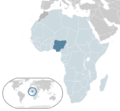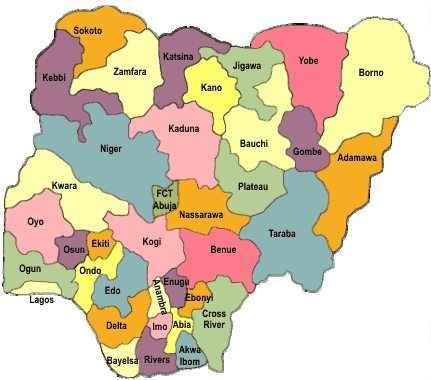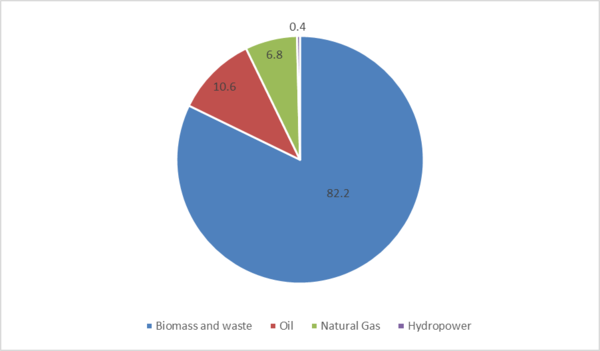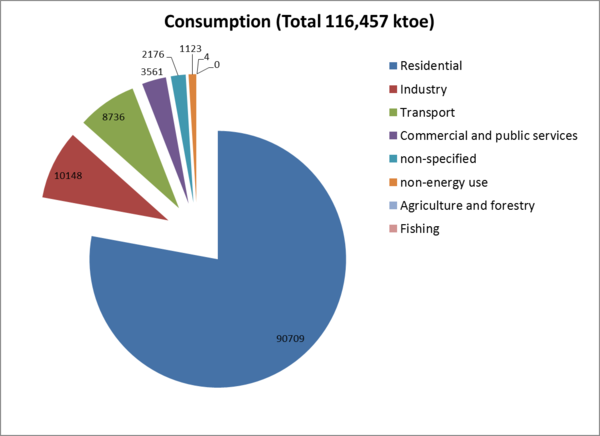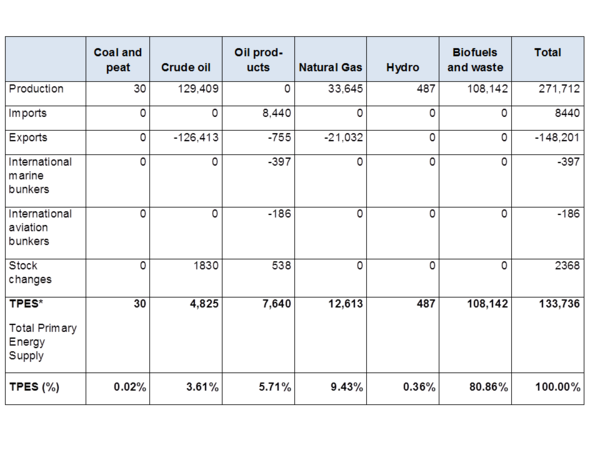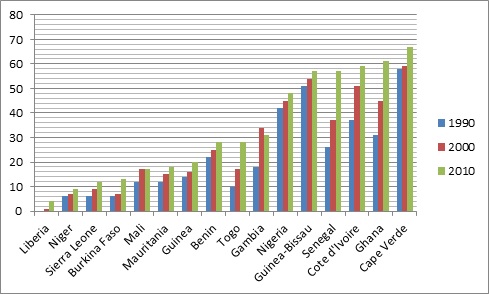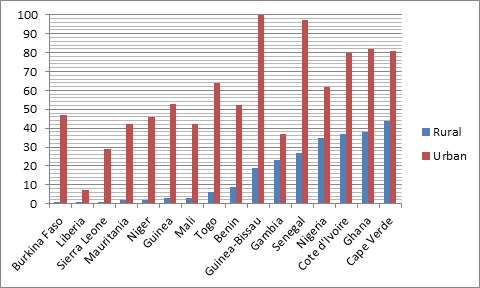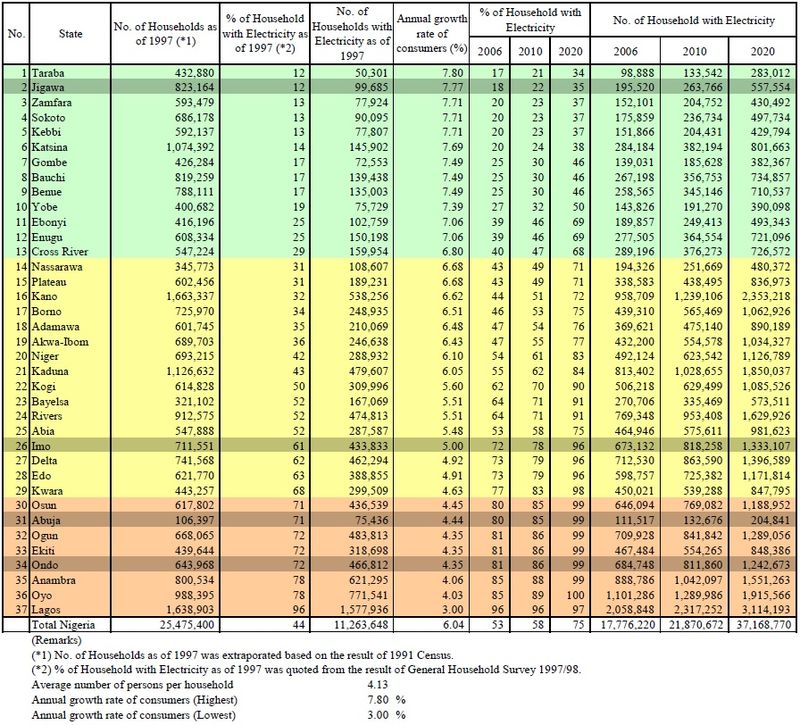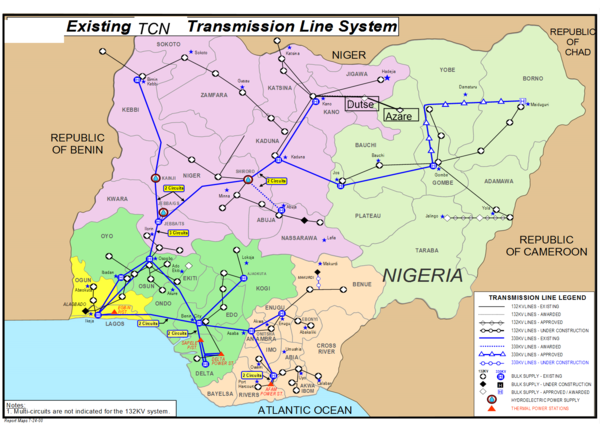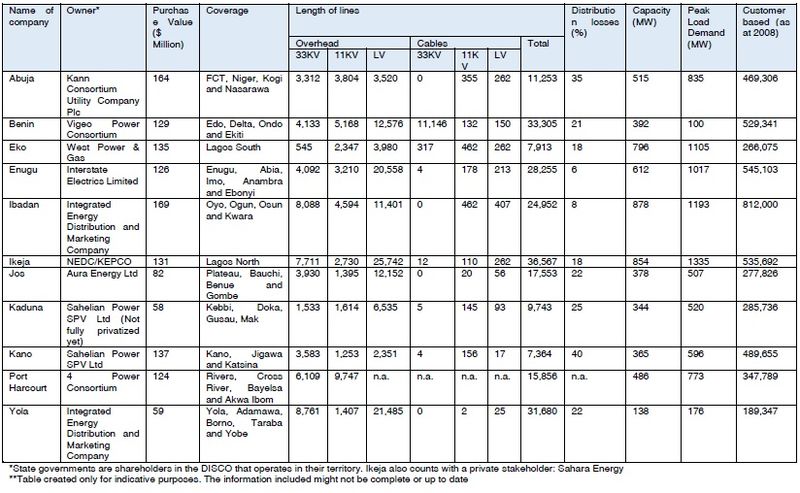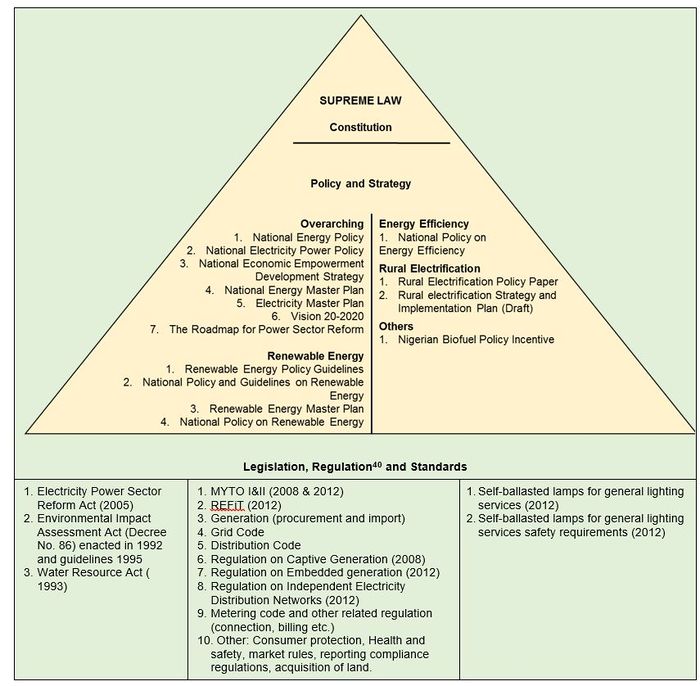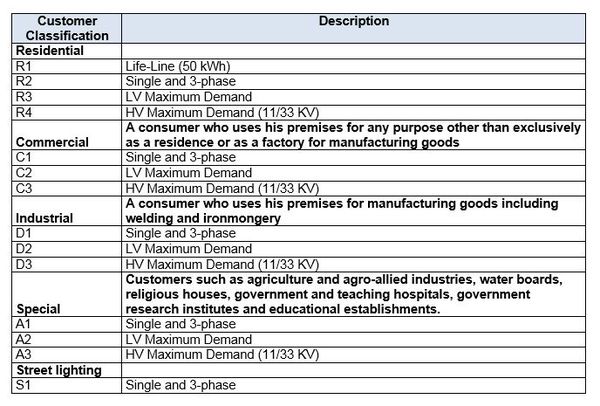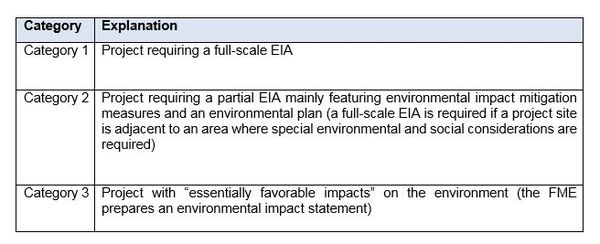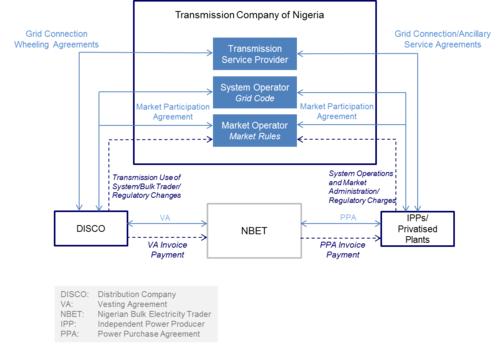Knowledge fuels change
For over a decade, Energypedia has shared free, reliable energy expertise with the world.
We’re now facing a serious funding gap.
Help keep this platform alive — your donation, big or small, truly matters!
Thank you for your support
Nigeria Energy Situation
Capital:
Abuja
Region:
Coordinates:
8.0000° N, 10.0000° E
Total Area (km²): It includes a country's total area, including areas under inland bodies of water and some coastal waterways.
XML error: Mismatched tag at line 6.
Population: It is based on the de facto definition of population, which counts all residents regardless of legal status or citizenship--except for refugees not permanently settled in the country of asylum, who are generally considered part of the population of their country of origin.
XML error: Mismatched tag at line 6. ()
Rural Population (% of total population): It refers to people living in rural areas as defined by national statistical offices. It is calculated as the difference between total population and urban population.
XML error: Mismatched tag at line 6. ()
GDP (current US$): It is the sum of gross value added by all resident producers in the economy plus any product taxes and minus any subsidies not included in the value of the products. It is calculated without making deductions for depreciation of fabricated assets or for depletion and degradation of natural resources.
XML error: Mismatched tag at line 6.2 ()
GDP Per Capita (current US$): It is gross domestic product divided by midyear population
XML error: Mismatched tag at line 6. ()
Access to Electricity (% of population): It is the percentage of population with access to electricity.
XML error: Mismatched tag at line 6.no data
Energy Imports Net (% of energy use): It is estimated as energy use less production, both measured in oil equivalents. A negative value indicates that the country is a net exporter. Energy use refers to use of primary energy before transformation to other end-use fuels, which is equal to indigenous production plus imports and stock changes, minus exports and fuels supplied to ships and aircraft engaged in international transport.
XML error: Mismatched tag at line 6.no data
Fossil Fuel Energy Consumption (% of total): It comprises coal, oil, petroleum, and natural gas products.
XML error: Mismatched tag at line 6.no data
Introduction
Nigeria is a federal constitutional republic comprising thirty-six (36) states and the Federal Capital Territory (FCT), Abuja. Located in the West African sub-region, the country has a surface of nearly 1 million km2 and a population of over 223 million people. Between 2000 and 2014, Nigeria’s economy grew over 7% annually on average. From 2015-2022, growth rates decreased and GDP per capita flattened. In February 2024, inflation reached a high of more than 30%.[1]
The country enjoys a tropical rainforest and savanna climate in the south and central belt respectively as well as an arid/semi-arid climate in the north. It is blessed with enormous natural resources; crude oil and natural gas, tin, iron ore, coal, limestone, lead, zinc, arable land, solar (particularly in the north), hydropower (incl. 277 small hydro identified sites with a cumulative potential of 3,500 MW) and wind (mainly in the north and along the coastal line).
Figure 1. Map of Nigeria[2]
Energy Situation
Energy Supply
According to the statistics from the International Energy Agency (IEA), total Nigerian primary energy supply was 118,325 Kilotonne of Oil Equivalent (ktoe) - excluding electricity trade - in 2011. As depicted in the figure below, biomass and waste dominated with 82.2%. Renewable energy sources only accounted for a small share of the energy supply. For instance hydropower only accounted for 0.4%.[3] Wind and solar are also utilized, but at an insignificant level at present.
Figure 2: Energy supply by source in 2011 (in %)[4]
Biomass is the dominant energy source in Nigeria due to the huge reliance on the energy source for cooking and heating purposes by majority of the Nigerian people. In 2021, over 83 % of Nigerians lacked access to clean cooking technologies and fuels.[5] In rural areas, only 4.6 % of the population had access to clean cooking in 2021, compared to 32.8 % in urban areas.[6]
Energy Consumption
As per the chart below, in terms of the distribution of the energy demand, in 2012, the total final consumption was 116,457 ktoe, of which the residential sector accounted for most of the energy consumed.
Figure 4: Energy consumption by economic sector in ktoe[7]
Energy Balances
Table 1. Energy balances for Nigeria in 2012 kilotonne of oil equivalent (ktoe)[8]
- Totals may not add up due to rounding.
Cooking Energy
Solid biomass is the primary fuel in two thirds of Nigerian households, mainly in rural areas. 51% of all households use a 3-stone fire, while 9% use self-built biomass stoves and 5% use manufactured biomass stoves. Charcoal accounts for 4-6% of the biomass used. The use of biomass fuel is particularly widespread in rural Nigeria, where it is used by over 85% of households, much of it outside the commercial fuel market. LPG is used by 35% of urban households, but only 5% of rural households use it as a primary fuel. Kerosene is used by 17 % of Nigerian households in 2019, most of them situated in urban areas. Electricity is the primary cooking solution for only 1% of Nigerian households.[6]
Electricity
With a share of 2% in the total final energy consumption, electricity remains a marginal source of energy in Nigeria. Furthermore, electricity only represents 9% of the household’s total energy consumption.[3]
Electricity consumption from residential and commercial sectors represented 80% of the total electricity demand. The rest was covered by the Industrial, Street Lighting and Special Tariff sectors. The share of large consumers, such as industry or large commercial areas, only represented 1% of the total electricity consumption[9].
As shown in the graph below, compared to the other West African countries, Nigeria’s electrification rates are relatively high, but have progressed at a relatively slower pace. In 2010, electrification rates were at 48% having increased only by 5% since the early 1990s[10].
Figure 5: Trends in electrification rates in West Africa from 1990 to 2010[11]
As it can be seen in the figure 6, the gap between rural and urban electrification rates is lower than in other West African countries, but remains significant (Rural: 35% and Urban: 62%)[10].
Figure 6: Urban and rural electrification rates in West Africa in 2010[11]
Access rates also vary substantially amongst the states of Nigeria. For instance, according to the projections of the Japanese International Cooperation Agency (JICA), Taraba State had the lowest electrification rate in 2010 with 21% and Lagos the highest with 96%. Out of the 13 states that registered the lowest electrification rates, 10 were located in the North-West and North-East. The 8 states with the highest electrification rates were located in the South-West or South-South. Table 2 presents an overview of the state of electrification per state:
Table 2: Trends in electrification rates per state[12]
As a result of high economic growth and demographic pressure, in 2008, the Energy Commission of Nigeria (ECN) together with the International Atomic Energy Agency (IAEA) projected a demand of 15,730 MW for 2010 and 119,200 MW for 2030 under the reference scenario (7% yearly economic growth)[13]. Other actors like the defunct Power Holding Company of Nigeria (PHCN)[14] or World Alliance for Decentralized Energy (WADE) et al. have also developed scenarios[15]. The results of these studies vary widely, but they all conclude that the current gap between supply and demand is already very substantial (1:3) and that, it will become more entrenched under a ‘business as usual’ scenario.
On-grid vs. Off-grid electrification scenarios
The World Bank, ESMAP and KTH Division of Energy Systems Analysis have developed National High Resolution Dynamic Least Cost Options Plan for Universal Access to Electricity in Nigeria, Tanzania and Zambia in 2018. The web-based open source application presented here allows the users to select scenarios based on electricity consumption targeted (Tiers of access) and spatially related fuel costs. [16] For Nigeria, it is foreseen that aroung 60% of the population not yet connected will be connected by stand alone (PV) systems, while the investments costs for the grid-extensions are envisioned to be much higher than off-grid electrifications, 5.8 billion USD (80% of the 7 billion total investment costs).[17]
►Go to top
On-grid Generation
State
Installed capacity for on-grid power generation increased by 5,600 MW over the period 1968 to 1991 in Nigeria. However, the lack of significant investment in maintenance of the existing and in the construction of new infrastructure in the 1990s resulted in the decrease of capacity throughout the 1990s and 2000s. Other factors hindering on-grid power generation include shortage of gas supply, misaligned gas and infrastructural facilities, vandalization and sabotage of generating facilities, power evacuation constraints, etc. As of mid-2015, there were a total of 58 licenses for on-grid generation with a total on-grid generation capacity of 26,423.2 MW, mostly for thermal generation in the southern part of the country where the oil and gas fields are located. However, out of this figure, only 11,774 MW have been built. Due to poor maintenance, only 3,801.19 MW are currently generated as at June, 2015.
Most of the generation capacity is based on natural gas. The share of large hydropower in the energy mix for power generation has decreased due to the Government’s focus on thermal. The thermal/hydro mix is 84%/16% for the installed capacity, 84%/16% for the available generation capacity and thermal/hydro mix is 80%/20% for actual generation capacity.[18] Table 3 includes the list of on-grid generation companies and plants in Nigeria:
Table 3: Generation connected to the transmission network[12]
|
Name |
Fuel Type |
Year Completed |
Installed Capacity (MW) |
Installed Available Capacity (MW) |
Actual Generation Capacity (MW) as of May 2015* |
|---|---|---|---|---|---|
|
AES |
Gas |
2001 |
270 |
267 |
0 |
|
AFAM IV-V |
Gas |
1982 |
580 |
98 |
0 |
|
AFAM VI |
Gas |
2009 |
980 |
559 |
523 |
|
ALAOJI NIPP |
Gas |
2015 |
335 |
127 |
110 |
|
DELTA |
Gas |
1990 |
740 |
453 |
300 |
|
EGBIN |
Gas |
1985 |
1320 |
931 |
502 |
|
GEREGU |
Gas |
2007 |
414 |
282 |
138 |
|
GEREGU NIPP |
Gas |
2012 |
434 |
424 |
90 |
|
IBOM POWER |
Gas |
2009 |
142 |
115 |
92 |
|
IHOVBOR NIPP |
Gas |
2012 |
450 |
327 |
225 |
|
JEBBA |
Hydro |
1986 |
570 |
427 |
255 |
|
KAINJI |
Hydro |
1968 |
760 |
180 |
181 |
|
OKPAI |
Gas |
2005 |
480 |
424 |
391 |
|
OLORUNSOGO |
Gas |
2007 |
335 |
244 |
232 |
|
OLORUNSOGO NIPP |
Gas |
2012 |
675 |
356 |
87 |
|
OMOKU |
Gas |
2005 |
150 |
0 |
0 |
|
OMOTOSHO |
Gas |
2005 |
335 |
242 |
178 |
|
OMOTOSHO NIPP |
Gas |
2012 |
450 |
318 |
90 |
|
RIVERS IPP |
Gas |
2009 |
136 |
166 |
0 |
|
SAPELE |
Gas |
1978 |
900 |
145 |
81 |
|
SAPELE NIPP |
Gas |
2012 |
450 |
205 |
116 |
|
SHIRORO |
Hydro |
1989 |
600 |
480 |
350 |
|
ODUKPANI |
Gas |
2013 |
561 |
70 |
0 |
|
Total |
|
|
12,067 |
6,840 |
3,941 |
|
| ||||
Challenges
As previously mentioned, the significant gap between demand and supply of electricity, has led to recurrent power shortcuts. Thus, the heavy reliance on gas, limited technical/technological know-how, lack of energy efficiency practices and infrastructure maintenance, inadequate regulations and attacks on energy infrastructure contribute to the challenges the sector faces.
Plans and Potential
In order to bring a solution to these problems, the Federal Government of Nigeria (FGN), in its Power Sector Reform Roadmap (2013), set the ambitious targets to increase installed hydro to 5,690 MW, thermal to over 20,000 MW and renewable 1000 MW capacities by 2020[19]. The targets also aim at diversifying Nigeria’s energy mix to reduce its natural gas dependence.
As an emergency solution, many Electricity Distribution Companies (through Independent Power Producers – IPPs) and States are currently investing in embedded generation (medium scale generation, generally less than 20MW, directly connected to the distribution network). There are 3 licenses for embedded generation with a total installed capacity of 133 MW[20]. Examples are the Eko Electricity Distribution Company that launched a bidding process for several Independent Power Producer (IPP) gas power plants below 20 MW and the Sokoto State Government that is in the process of finalizing the construction of a 38 MW diesel power plant (to be then converted into gas). Another example is Nigerian Electricity Supply Company (NESCO), a company based in Plateau that has been operating a small-hydropower plant as an Independent Power Producer (IPP) since 1993 and from which the State Government buys electricity in bulk[21].
Nigeria has vast crude oil (37.2 billion barrels as of 2012) and natural gas (5.2 trillion cubic metres as of 2012) resources that could be exploited to increase its generation capacity. As of mid-2014, four thermal power plants were being constructed: Calabar Generation Company Ltd (634 MW), Egbema Generation Company Ltd (381 MW), Gbarain Generation Company Ltd (254 MW) and Omoku Generation Company Ltd (265 MW). Other large gas power plants are being planned such as the 459 MW Azura Edo Independent Power Producer (IPP) and the 533 MW Qua Iboe Independent Power Producer (QIPP) projects[22]. Nigeria also envisages the use of its coal reserves to produce power. The country also aspires to generate power from nuclear.
As shown in Table 4, in addition, the country is endowed with vast renewable energy wealth which the authorities also intend to utilize for power generation purposes.
Table 4: Renewable energy potential in Nigeria[23]
|
Energy Resources |
Estimated Reserve |
|
Large Hydropower |
11,250 MW |
|
Small Hydropower (<30 MW) |
3500 MW |
|
Fuel Wood |
11 million hectares of forest and woodland |
|
Municipal Waste |
30 million tonnes/year |
|
Animal Wastes |
245 million assorted animals in 2001 |
|
Energy Crops and Agricultural Residue |
72 million hectares of agricultural land |
|
Solar Radiation |
3.5-7.0 kW h/m2/day |
|
Wind |
2-4 m/s at 10 m height Wind speeds in Nigeria range from a low 1.4 to 3.0m/s in the Southern areas, except for coastal line and 4.0 to 5.1m/s in the North. The Plateau area particularly interesting. |
A 10 MW pilot wind plant has been built in Katsina and is awaiting commissioning. One major hydropower plant is now under development, the Zungeru 700 MW plant in Niger State. A number of smaller hydropower plants are also being planned such as Gurara (30 MW) or Kashimbilla (40 MW). The 3,050 MW Mambilla hydropower plant project is currently being reviewed. In addition, the Nigerian Electricity Regulatory Commission (NERC) has issued licenses for 8 solar projects totaling a capacity of 868 MW and a 100 MW wind park[22]. Furthermore, investors are increasingly enthusiastic about developing large solar plants in the country.
"Despite the potential for renewable energy to contribute to solving Nigeria’s deficient grid infrastructure, there is no grid-based renewable energy electricity production at the moment (apart from large scale hydro), and the perception that renewables are a high-risk investment still prevails. Fourteen solar PV companies signed power purchase agreements (PPAs) with the bulk electricity trader in 2016, with a combined capacity of 1 GW, but as of 2019 none of them have yet reached financial close."[24]
Transmission and Distribution Network
State
The national transmission grid has an installed capacity of 5,758 MW, but its effective wheeling capacity lies at about 4,500 MW[25]. The transmission network has a total length of 12,300 km (330 kV 5,650 km, 132 kV 6.687 km)[26] and connects 32 330 kV and 105 132 kV substations[27]. It is managed by the Government owned Transmission Company of Nigeria (TCN). The Government has contracted Manitoba Hydro International (MHI) to operate it.
Figure 7. The Existing Transmission Company of Nigeria (TCN) Line[28]
The distribution network has a length of 224,838 km (taking into consideration 33KV, 11KV and LV lines overhead and cables. As part of the power sector reform, the network was split into 11 distribution zones, each of them now owned and managed by a different Electricity Distribution Company (DISCO), with the exception of the Kaduna Electricity Distribution Company whose privatization process is still ongoing.
The Ikeja Electricity Distribution Company is the one with the longest grid (36,585 km), while Kano is the one with the shortest (7,404 km) and also the highest losses (40%). The Ibadan network is the one with the highest capacity (878 MW) and highest number of customers (812,000 customers), while the Ikeja network is the one with the highest peak demand (1,400 MW) due to the high concentration of economic activities in Lagos State. Table 5 includes information on the distribution network per Electricity Distribution Company (DISCO):
Table 5: Electricity Distribution Companies and the state of their network[29]
At the end of 2014, there also were 138 companies with licenses as metering service providers; of which, 5 certified as meter manufacturers; 13 companies as importers, 28 companies as meter vendors, 13 companies as individual meter installers and 79 as corporate installers[30].
►Go to top
Challenges
Due to poor maintenance and vandalization, the transmission network is currently overloaded and experiences losses of 25%, which are particularly high in the north[31].
The radial network is unreliable and contributes to a high number of system collapses. Other factors include right of way negotiation and payments, community/security issues, non-performing engineering, procurement, construction and commissioning (EPCC), high costs of grid-extension, bureaucracy, huge manpower deficits, etc.
The distribution grid also suffers from high technical and non-technical losses, lack of skilled distribution sub-station operators (manpower), electricity theft, vandalization of distribution equipment, a poor maintenance regime aggravated by lack of a centralized and automatized control system, inadequate funding, distribution/transmission interface issues, inefficient revenue collection, etc.
Nigeria’s average electricity consumption per inhabitant is only 150 kWh per capita, one of the lowest in the world[32]. It is estimated that, in 2011, grid-connected customers suffered an average of 28 blackouts per day[32]. Regular black-outs also make necessary the use of stabilizers in order to protect electronic equipment and appliances which add to the costs faced by end-users.
This situation does not only affect the population’s living standards, but it is also one of the biggest challenges to economic development. The closure of industries such as textile factories in the 1990s in states like Kaduna, Kano or Lagos is often cited as a proof of the effect of de-industrialization caused by an unstable power supply and network[33]. The Council for Renewable Energy of Nigeria (CREN) estimated in 2009 that power outages brought an annual loss of about 126 billion naira (US$ 984 million)[34]. Additionally, Nigeria remains one of the most difficult countries to set up an electricity connection with an estimated time duration of 260 days and a cost of 960% of income per capita[35].
Plans
A Network Expansion Blueprint was created in 2013 for the transmission framework. The study estimates the need for a capacity of 16,000 MW by 2017. As a result, TCN is currently refurbishing the transmission network and has launched over 165 on-going projects[31]. Several hundreds of projects are already ongoing, including a project to create a super grid of 700 KV all around Nigeria[26].
The Roadmap for Power Sector Reform also includes targets for the increase in the distribution capacity of 32,774 MW by 2020[36]. While the plans for the realization of the transmission targets are developed on a centralized level at the Transmission Company of Nigeria (TCN), the achievement of distribution capacity targets will require the joint efforts of the 11 distribution companies. Progress made by the distribution company in this regard is the responsibility of the Nigerian Electricity Regulatory Commission which negotiates targets on grid expansion and densification as well as loss reduction on annual basis through the Key Performance Indicators (for more information, please refer to the chapter on regulation)
►Go to top
Decentralised Generation
Status
Off-grid licences cover a production capacity of only 305 MW, while embedded generation capacity represents 49 MW.[37] Electrification trends, particularly for rural remote areas, have not progressed as fast as they have been expected. In addition to the high demographic pressure, the strong focus on main-grid extension of the Federal and State Government’s electrification programmes raising substantially project costs for low density and remote areas with low consumption and capacity to pay are often regarded as reasons for this remote progress. This has been further aggravated by high levels of political interference when it comes to the prioritization of areas to be electrified. Intra- and inter-community conflicts have also resulted in delays in the country’s electrification programme.
Recurrent unscheduled blackouts have pushed the population and businesses to invest in self-generation. It is estimated that only 50% of the electricity generated comes from the grid, while the other half is generated from individual power sources, generally small petrol/diesel generators. In 2009, the total capacity of individual power sources from petrol and diesel generators was conservatively estimated at 6000 MW[38].As of 2006, the Federal Capital Territory, Lagos and the South-South and South East, particularly the Niger Delta states (Delta, Bayelsa and Rivers), were the ones with the highest concentration of generators[39].
Businesses are the ones that have invested the most on self-generation. There are 20 licenses summing up a total capacity of 305.5 MW for off-grid (self) generation, most of them for industries. There is also one license for off-grid distribution which covers certain areas of Ogun State where the National Grid does not reach[40].
Off-grid electrification using conventional sources dates back to the 1970s when the Federal Government through its Rural Electrification Programme decided to electrify all Local Government Areas Headquarters that were off-grid with off-grid diesel powered generated systems.
Renewable energy based off-grid electrification is a more recent development. In the 1990s, the Energy Commission of Nigeria (ECN) and the former Federal Ministry of Power and Steel pioneered the installation of off-grid PV in Nigeria, including mini-grids and stand-alone systems for residential, irrigation and cooling purposes[41]. More recently, the Rural Electrification Agency (REA) and the Federal Ministry of Environment (FME) have also started developing these projects. The Federal Ministry of Power also in 2014 launched the initiative; Operation Light-up Rural Nigeria, which is aimed at utilizing renewable energy for electrifying rural communities in all 36 States in the country including the Federal Capital Territory (FCT).
Although States’ electrification interventions focus mainly on grid extension, some have also installed off-grid Photovoltaic (PV) water pumping systems and off-grid Photovoltaic (PV) street lighting. Some of them have implemented some off-grid Photovoltaic (PV) village electrification projects together with the private sector.
From a survey including 55 companies carried out by the Nigerian Energy Support Programme (NESP) in 2015, all together these companies had installed about 2,033.75 kW of off-grid Photovoltaic (PV) combining mini-grids and stand-alone systems. Most of them have been installed for residential or commercial purposes in un-electrified rural areas, but there are also some that have been built in grid connected areas as grid backup systems. Most of the mentioned projects were installed using full grants from international donors or the federal, state and local government.
Small wind turbines for water pumping have also been installed in some parts of the country for testing. For instance, the Sokoto Energy Research Centre (SERC) installed a turbine in Sayya Gidan Gada Village, Sokoto. SERC, together with the World Bank (WB), ECN and the Sokoto Government, installed a hybrid mini-grid combining 10 kW solar and 2 kW wind in Danjawa Village, Sokoto. Other technologies such as off-grid PV street lighting have also been tested in Danjawa.
There are as well some experiences with regards to small hydropower. One of the main actors in this regard is the United Nations Industrial Development Organization (UNIDO) and its International Small Hydropower Regional Centre and to a lesser extent the United Nations Development Programme (UNDP). Examples of projects developed by latter are Evboro II pico-hydropower plant in Edo State, the 70 kW micro-hydropower plant in Osun State, installed using National Agency for Science and Engineering Infrastructure’s (NASENI) local turbine technology, or the 400 kW mini-hydropower plant in Taraba State. All the above mentioned hydropower projects will be used mainly for village electrification with the exception of the last one which will be used for self-generation at a beverage company. Excess power will be sent to the surrounding villages. The Energy Commission of Nigeria (ECN) has also installed a pico-hydropower pilot project in Nasarawa State to test the kinetic turbine technology. With regards to biomass, there is information of a 5 MW biomass powered mini-grid project by United Nations Industrial Development Organization (UNIDO), but there is no information as to what is the stage of the project. Notable progress by private local investors are increasingly recorded on biomass energy deployment for rural electrification especially in the south-western and middle-belt areas of Nigeria e.g. 72 Naira per liter of biofuel by Biodiesel Nigeria Limited.
►Go to top
Planned Mini-grids Projects
Solar Nigeria for the People Limited has signed a Community Agreement with the Ode Omi Community to build Nigeria's largest rural mini-grid. This project will be commissioned in September 2019 and will supply a peak load of 99 kW in its first phase and up to 500 kW in its second phase. It will also electrify 634 households, 7 schools, 3 hospitals, 8 religious organizations and more than 90 businesses in the community. The company will invest half a million dollars to build this mini-grid. The company also shares its plan to train more than 50 youths from Ode Omi Community in the construction phase of the mini-grids and also employ security personnel from the community. It will also empower the existing recharge card vendors to earn additional revenue by selling prepaid meter credits during the operation phase of the mini-grids[42]
Challenges
The diesel/petrol generator- based self-generation sector is at an advanced state of maturity. On the contrary, due to inter alia the low retail prices of diesel and petrol and low levels of end-user awareness, the renewable energy sector remains in its infancy and nearly completely dependent on grants. Most of the off-grid rural electrification projects have failed due to the lack of technically (with inadequate operations and maintenance or tariff collection mechanisms) and financially viable business models, lack of access to equity and debt with low interest rates and long tenor periods and the risk of main-grid connection. Systems are normally installed without having carried out a thorough assessment of end-user needs. Inadequate customer relationship/communication strategy and renewable energy/energy efficiency education with systems being handed over to beneficiaries for operations and maintenance without prior training. In spite of the high dependence of the off-grid renewable energy sector on public support, the sector’s framework remains unfinished without a rural electrification strategy, coordinated institutional and regulatory framework as well as a well-managed rural electrification fund.
►Go to top
Plans
There is strong political commitment from the Federal Authorities through the FMP and the REA as well as from the State Authorities. At the state level, electrification plans are currently being developed with support from the Nigerian Energy Support Programme’s (NESP) Mini-grid Development Business Accelerator Facility, which aims to accelerate the development of mini-grids in rural areas of Nigeria through private sector involvement. At the federal level, initiatives such as Light-up Rural Nigeria launched by the FMP are planning on developing a number of solar mini-grids over the next years.
In May 2019, the Rural Electrification Agency of Nigeria has launched the mini-grid and solar home components of the Nigeria Electrification Project. The mini grid component aims to extend electricity services to 300,000 households and 30,000 enterprises in rural areas by 2023. The component is private sector led and provides viability gap subsidies to mini grid developers under two funding windows. Interested Applicants should submit their applications June 3rd, 2019.[43]
►Go to top
Key Problems of the Energy Sector
According to Power Africa, these bottlenecks would be the biggest for Nigeria's energy sector[44]:
- Macroeconomic forces
- Lack of credible and reliable utilities
- Lack of strong, transparent regulator
Policy Framework, Laws and Regulations
Nigeria’s government makes continuous effort for the development of framework for the on-grid power sector, particularly with regards to the conventional sector. Furthermore, over the recent years, increasing progress have been made on the policy and regulatory framework on renewable energies. Seemingly, the framework for medium scale interconnected generation (embedded generation) is also being elaborated at a fast pace due to the importance of this aspect for the Electricity Distribution Companies (DISCOs) and overall energy supply. On the contrary, most of the strategy and policy documents for rural electrification, particularly off-grid, and also energy efficiency remain in draft form and still need to be developed considering inherent realities associated with the sector. There is however, a gap between the policy framework and their operationalization through the formulation and effective implementation on plans with a clear roadmap. Below is a chart listing all existing legislative, policy and regulatory documents for the energy/power, renewable energy and electrification sub-sectors in Nigeria, which are then described in greater detail in the subsequent subsections:
Figure 8: Pyramid listing the main legislative, policy and regulatory energy sector related documents in Nigeria[22]
Legislation
The Constitution of the Federal Republic of Nigeria 1999 (CAP. C23 L.F.N. 2004) gives the National Assembly the power to legislate over the power sector (Part II, Paragraph 13) and the Houses of Assembly of the States over areas not covered by the national grid (Part II, paragraph 14).
The Electric Power Sector Reform Act (EPSRA) from 2005 is the key legislation that allowed for the ongoing power sector reforms. The Act also makes provision for the creation of key entities in the liberalized power sector like the Nigerian Electricity Regulatory Commission (NERC). It also gives guidance with regards to the issuance of licenses, calculation of tariffs, land access rights, etc. It also allows for the unbundling of the sector with the creation of Transmission Company of Nigeria (TCN) and the Nigerian Bulk Electricity Trader (NBET) and makes provisions for the creation of the Rural Electrification Agency (REA), including the Rural Electrification Fund (REF).
Policies, Strategies and Plans
Vision 20-2020 of 2009 developed by the National Planning Commission (NPC) is Nigeria’s long term development strategy designed to ensure that Nigeria becomes one of the top 20 economies of the world by 2020. It emphasizes the importance of the development of energy infrastructure as a means to attain the final objective. The target of 40,000 MW by 2020 is mentioned in the document.
Envisaged as a medium term plan (2003-2007), the National Economic Empowerment and Development Strategy (NEEDS) was developed by the National Planning Commission (NPC) approved in 2004 with the ultimate aim of achieving macroeconomic stability and supporting more efficient use of resources for economic growth. As for the vision, the strategy places high priority on the development of the power sector.
The basis for the energy sector is theNational Energy Policy (NEP) of 2003 developed and implemented by the Energy Commission of Nigeria. It covers all aspects of the energy sector, including renewable energy, energy efficiency and rural electrification, and sets the target of 75% electrification by 2020.
Created by a National Committee, the National Energy Master Plan (NEMP) of 2007 sets the implementation framework of the National Energy Policy (NEP). It covers all energy source, energy utilization, manpower development, energy financing, energy databank and the project cycle (planning, implementation and monitoring and evaluation).
The National Electric Power Policy (NEPP) of 2001 sets the specific framework for the power sector. It was developed and approved by the former Ministry of Power and Steel.
Building on the Electricity Master Plan (EMP) of 2008, Electric Power Sector Reform Act (EPSRA) and Vision 20-2020, the Presidential Task Force on Power (PTFP) created the Roadmap for Power Sector Reform in 2010 which was reviewed in 2013. It estimates that $3.5 billion will be needed annually in the power sector in the next ten years for its advancement and also establishes short, medium and long-term milestones in order to achieve this objective. The Roadmap identifies the main barriers affecting progress towards the full liberalization and the reduction in the supply/demand gap of the power sector.
The National Renewable Energy and Energy Efficiency Policy (NREEEP) of 2015 provides an overarching framework for renewable energy and energy efficiency, thereby functioning as an umbrella policy for the various existing documents and serving as a reference document (anchor) for concrete implementation measures.
Furthermore, there are several attempts (ongoing) to develop renewable energy policies and master plans. The Energy Commission of Nigeria (ECN) together with the United Nations Development Programme (UNDP) created the Renewable Energy Master Plan (REMP) in 2006 which was reviewed in 2012. The former Ministry of Power and Steel together with the International Centre for Energy, Environment and Development (ICEED) created the Renewable Electricity Policy Guidelines in 2006, focusing on the use of small scale renewables for rural electrification, regarded as a predecessor of the Renewable Energy Master Plan (REMP). Also in 2006, the same two actors launched the Renewable Electricity Action Programme (REAP) operationalizing the guidelines. Japan International Cooperation Agency (JICA) together with the Federal Ministry of Water Resources (FMWR) has created several Hydropower Master Plans (1993, 1995, 2013) and, in 2007, the Solar Energy Master Plan. The Nigerian National Petroleum Corporation (NNPC) also issued in 2007 the National Bio-fuel Policy and Incentives which formulates a biofuel support programme aiming at integrating the agricultural sector of the economy with the downstream petroleum sector.
The Rural Electrification Policy Paper (REPP) created by the Federal Ministry of Power (FMP) and approved in 2009 establishes the framework and objectives for a rural electrification programme. It sets the target of 10% of renewable energy mix by 2025.
The Electric Power Sector Reform Act (EPSRA) gives the mandate to the Rural Electrification Agency (REA) to develop its own Strategy and Plan (in close collaboration with Nigerian Electricity Regulatory Commission (NERC) and operationalize the Rural Electrification Fund (REF) and to submit them to the Minister of Power for approval. A committee gathering the main actors involved in the power sector was established to review the preliminary draft of the Rural Electrification Strategy and Plan (RESP) which is expected to establish a clear institutional step-up for the sector and set a roadmap that results in the establishment of an enabling framework for rural electrification in Nigeria. The draft of the strategy is ready and awaiting approval. Seemingly, the draft guidelines to operationalize the Rural Electrification Fund (REF) is also ready.
In 2012, the Federal Ministry of Power (FMP) in close collaboration with Energy Commission of Nigeria (ECN), Federal Ministry of Environment (FME) and United Nations Development Programme (UNDP) also created a National Energy Efficiency Policy identifying the main challenges, setting targets and an institutional set-up. The document is still in a draft form.
As part of the Sustainable Energy For All (SE4All) initiative, the Federal Ministry of Power (FMP) jointly with the ECOWAS Centre for Renewable Energy and Energy Efficiency (ECREEE) and the Nigerian Energy Support Programme (NESP) are in the process of elaborating National Renewable Energy and Energy Efficiency Action Plans.
Regulation
The Electricity Power Sector Reform Act (EPSRA) exempts from license those systems that “generate electricity not exceeding 1 megawatt (MW) in aggregate at a site or an undertaking for distribution for electricity with a capacity not exceeding 100 kilowatts (KW) in aggregate at a site, or such other capacity as the Nigerian Electricity Regulatory Commission (NERC) may determine from time to time, without a licence” (Part IV Licences and Tariffs, 62.2). In this line, the activity of the Nigerian Electricity Regulatory Commission (NERC) has focused on establishing a solid regulatory framework covering the systems that require a licence.
With regards to the systems requiring licensing, the Nigerian Electricity Regulatory Commission (NERC) has approved regulations for generation procurement (e.g. NERC, 2014, Generation Procurement Guidelines and NERC, 2012, Generation Procurement Regulation). Seemingly, the Nigerian Electricity Regulatory Commission (NERC) has also developed regulation for the importation of equipment (NERC, NERC G-0111: Guidelines for Obtaining Clearance Certificate for the importation of generating sets and related matters).
The Regulator also set the Multi-Year Tariff Order (MYTO), which covers a total of 15 years going forward and is reviewed biannually. It also sets a feed-in tariff in order to ensure there are clear rules in the transitional electricity market. The latest review of the Multi-Year Tariff Order II (MYTO II) took place in 1 June 2012 and will be valid until 31 May 2017. In addition to thermal generation, the order also covers large and small hydropower as well as wind and solar.[45] This is however an indicative document. The holder of a licence for generation has to negotiate its tariffs with the Nigerian Bulk Electricity Trader (NBET), which is responsible for developing the Power Purchase Agreements (PPAs).
The Nigerian Electricity Regulatory Commission (NERC) has also developed a Grid Code for the Nigeria Electricity Transmission System Version 2. It also approved a Distribution Code for the Nigeria Electricity Distribution System Version 1. Although the regulation for conventional generation is well established, the one for interconnected renewables is in the process of being established or mainstreamed into other regulation. In this line, the Codes are now under review in order to adapt it to the interconnection of renewable energies. In line with the Multi-Year Tariff Order (MYTO), the Nigerian Electricity Regulatory Commission (NERC) also negotiates the tariffs of the 11 Electricity Distribution Companies (DISCOs) on a case by case basis following the categories mentioned below:
Table 6: End-user electricity tariffs as per MYTO[46]
The agreed tariffs are included in a contract with the Nigerian Electricity Regulatory Commission (NERC) which also features Key Performance Indicators (KPI) in accordance with NERC, 2009, Reporting Compliance Regulations. This system allows the Nigerian Electricity Regulatory Commission (NERC) to steer and monitor progress of electrification with a view to ensure the achievement of policy targets.
The Nigerian Electricity Regulatory Commission (NERC) has also developed a metering code and other related regulation for connection as well as meter reading, billing, etc.
In addition, to the regulation relating to the conventional on-grid sector, the Nigerian Electricity Regulatory Commission (NERC) has also developed regulation for alternative generation and distribution:
The Nigerian Electricity Regulatory Commission (NERC), Regulations for Independent Electricity Distribution Networks (IEDN) (2012) covers isolated generation and distribution requiring license in line with Part IV Licences and Tariffs, 62.2.
Two documents provide for regulation regarding generation that does not feed into the transmission network: embedded and captive generation for systems with a capacity above 1MW.
- NERC, 2012, Regulations For Embedded Generation: “Embedded Generation or EG” covers the generation of electricity that is directly connected to and evacuated through a distribution system which is connected to a transmission network operated by a System Operations Licensee.
- NERC, 2008, Regulation No: NERC-R-0108: “Captive Power Generation” regulates generation of electricity exceeding 1 MW for the purpose of consumption by the generator, and which is consumed by the generator itself, and not sold to a third-party.
The draft Rural Electrification Strategy and Plan (RESP) of May 2014 gives the Nigerian Electricity Regulatory Commission (NERC) the mandate to regulate over the rural electrification sector, including systems that do not require a licence. The document states that the sector will be self-regulated via bilateral agreements between system owners and the Nigerian Electricity Regulatory Commission (NERC) and a template electricity supply contract. It also gives the mandate to the Nigerian Electricity Regulatory Commission (NERC) to create a tariff methodology, a protocol for the handover of assets in cases where the assets of the rural operator meet the ones of the Electricity Distribution Company (DISCO). It also gives the Nigerian Electricity Regulatory Commission (NERC) together with the Rural Electrification Agency (REA) the mandate to develop standards covering several aspects. The mentioned is now being drafted by the Nigerian Electricity Regulatory Commission (NERC) with the support of the Nigerian Energy Support Programme (NESP).
All the mentioned documents are accompanied by other regulation on health and safety, consumer protection as well as land access rights. In case of hydropower projects, licence applicants also need to get access to water rights for which the Federal Ministry for Water Resources (FMWR) is responsible as mentioned in the Water Resource Act of 1993. A new act is now being developed.
The Commission has also developed regulation to safeguard healthy levels of competition in the liberalized power market (e.g. Market Rules, Reporting Compliance Regulation, Business Rules).
Environmental Impact Assessment
The Federal Ministry of Environment (FME) is responsible for the Environmental Impact Assessment (EIA) which is implemented in accordance with the Environmental Impact Assessment Act (Decree No. 86) enacted in 1992 and the guidelines promulgated in 1995. All development projects are classified in one of the following three categories based on the guidelines.
Table 7: Description of the different categories of EIA depending on size of project and type of power generation technology[47]
The regulatory document Requirements for Licences to be granted pursuant to the application for licences (generation, transmission, system operation, distribution and trading) Regulations of 2006 also mentions a simplified procedure replacing the Environment Impact Assessment (EIA) for off-grid and captive generation below 10 MW called Policy for Managing Effluents and Discharges.
Institutional Set-up in the Energy Sector
Over the years, a myriad of institutions and bodies have been created in Nigeria to steer the energy sector. This has led to overlapping mandates and regular conflicts amongst institutions and bodies adding to the already complex relation between the Federal and State levels and further affecting the much needed coordination in the sector. The institutional set-up as a whole and many of its institutions have initiated a restructuring process to respond better to the needs of the newly liberalized power sector. This process is expected to improve the institutional coordination and complementarity. To ensure the sector coordination the Federal Ministry of Power (FMP) established the Inter-Ministerial Committee on Renewable Energy and Energy Efficiency (ICREEE) composed of the key power sector actors. The Committee has rather had a limited impact. The Nigerian Energy Support Programme (NESP) has supported the Federal Ministry of Power to re-activate it.
Table 8: Indicative roles played by key each actor in the energy sector
|
Actors |
Policy (coord.) |
Planning |
Regulation |
Projects |
|
Federal Ministry of Power (FMP) |
X |
X |
X | |
|
Rural Electrification Agency (REA) |
X |
X | ||
|
Nigerian Electricity Regulatory Commission (NERC) |
X |
|||
|
Electricity Distribution Companies (DISCOs) |
X |
X | ||
|
States |
X |
X |
X | |
|
Local Governments |
X | |||
|
Others: Energy Commission of Nigeria (ECN), Federal Ministry of Environment (FME) |
X |
X |
X | |
|
Table created only for indicative purposes. The information included might not be complete or up to date. | ||||
In addition to the Federal Ministry of Power (FMP) that is supposed to be the main actor in the sector responsible for policy formulation, planning, coordination and monitoring, the Presidency also decided to get directly involved in the power sector reform with the creation of the Presidential Action Committee on Power (PACP) and the Presidential Task Force on Power (PTFP). The Federal Ministry of Power (FMP) is one of the institutions that is currently undergoing a restructuring process to adapt to the new structure of the liberalized power sector with the newly created Department of Renewable and Rural Power Access in the Ministry.
The Electricity Power Sector Reform Act (EPSRA) provided for a new institutional set-up for the reformed power sector. It created the Nigerian Electricity Regulatory Commission (NERC) in charge of regulating the sector (including licensing) and ensuring compliance of actors with market rules. It unbundled the former public utility, Power Holding Company of Nigeria (PHCN). As a result, a number of thermal power generation plants have been privatized (see third table on generation for more information on generation companies). Others are awaiting privatization under the National Independent Power Producer (NIPP) Programme managed by the Niger Delta Power Holding Company Limited (NDPHC). The hydropower plants have been franchised. The transmission sector remains public under the control of the Transmission Company of Nigeria (TCN) managed by a private company (Manitoba Hydro International of Canada). The distribution sector has been completely privatized with the creation of 11 zones that were sold to the private sector in an open competitive bidding process (see fourth table for more information on the electricity distribution companies). With a view to ensure the transition towards a fully privatized power market, the Act also foresaw the creation of the Nigerian Bulk Electricity Trader (NBET) responsible for purchasing electricity from generation companies and selling it to distribution companies.
Due to the heavy reliance of power generation on gas and in order to ensure gas supply to the power generation companies, a Gas Aggregation Company of Nigeria (GACN) was established with the mandate to facilitate natural gas trade between suppliers and purchasers. The Nigerian Gas Company Limited (NGC) was created to transport natural gas through its pipeline network.
Figure 9. The Transmission Company of Nigeria (TCN)[48]
In order to narrow down the gap between rural and urban electrification, the Electricity Power Sector Reform Act (EPSRA) also created the Rural Electrification Agency (REA), responsible for stimulating rural electrification through various instruments, including subsidization. Nonetheless, since the Rural Electrification Agency (REA) framework has not yet been fully finalized, the Agency carries out implementation of “constituency” projects, mostly main-grid extension, as well as off-grid renewable energies, upon requests from communities or political authorities using the monies of the federal executive which are directly allocated to specific projects. Other actors, like the Federal Ministry of Power (FMP), the Federal Ministry of Environment (FME) and the Energy Commission of Nigeria (ECN) also carry out constituency projects using off-grid renewable energy systems.
The Constitution gives States the power to do generation, transmission and distribution in areas that are not yet covered by the national grid. As a consequence, States and Local Governments also carry out electrification projects, mostly grid extension to rural areas using their own budgets.
Figure 10: Structure of the Power Sector Post-Privatization[49]
Description of the Main National Public Actors in the Energy Sector
- The Presidency of the Federal Republic of Nigeria Presidential Action Committee on Power (PACP) : The Presidency created an ad-hoc body under its direct control responsible for steering progress in the context of the Power Sector Reform. The Presidential Action Committee on Power (PACP) has the mandate to give guidance to the Presidential Task Force on Power (PTFP) which is the operational body. Its mandate is to create a Roadmap which ensures the transition towards a fully operational liberalized power sector. The Presidential Task Force on Power (PTFP) coordinates, supports and monitors its implementation. The Presidential Task Force on Power (PTFP) is also in charge of key short term power infrastructural projects.
- National Planning Commission (NPC): Established by the Act 71 of 1993, it is in charge of formulating, coordinating and monitoring the implementation of national development plans and ensuring coordination and monitoring of development efforts by all stakeholders. The National Planning Commission (NPC), together with all the relevant actors, developed Vision 2020 for the energy sector which led to the reform agenda of the sector. The Commission also works very closely with the Presidential Task Force on Power (PTFP).
- Bureau of Public Enterprises (BPE): The Bureau Of Public Enterprises (BPE) serves as the secretariat of the National Council on Privatisation (NCP) and is charged with the overall responsibility of implementing the Council's policies on privatization and commercialization. In the case of the power sector reform, it was charged with the management of the privatization process of the electricity generation and distribution companies.
- Federal Ministry of Power (FMP): Formerly Federal Ministry of Power and Steel, it is in charge of policy formulation and coordination in the power sector, including on renewable energies and energy efficiency. It also supervises a number of agencies/parastatals: Rural Electrification Agency (REA), Electricity Management Services Limited (EMSL), Nigerian Bulk Trading Company (NBET), Transmission Company of Nigeria (TCN), National Power Training Institute of Nigeria (NAPTIN) and Niger Delta Power Holding Company (NDPHC). The Ministry heads the Inter-Ministerial Committee on Renewable Energy and Energy Efficiency (ICREEE) composed of the Nigerian Electricity Regulatory Commission (NERC), Rural Electrification Agency (REA), Energy Commission of Nigeria (ECN), Nigerian National Petroleum Commission (NNPC) and Federal Ministry of Environment (FME) (see below for more information on the mentioned actors). The Federal Ministry of Power (FMP) is also directly in charge of inspecting, testing and certifying grid connected generation, transmission and distribution. It is also responsible for the implementation of renewable energy on-grid and off-grid pilot projects such as the 10 MW wind park in Katsina, Mambilla and Zungeru large hydropower projects and the micro-grids developed under the Operation Light-up Rural Nigeria. The liberalization in the power market has resulted in a change in the needs of the sector. As a consequence, the Federal Ministry of Power (FMP) is now undergoing a restructuring process that will allow it to adapt to the new context. In this context, a new department entitled “Renewable and Rural Power Access” was created.
- Nigerian Electricity Regulatory Commission (NERC): Established under Part III – Establishment, Functions and Powers of the Nigerian Electricity Regulatory Commission – of the Electricity Power Sector Reform Act (EPSRA). Its mandate is to monitor and regulate the power sector and ensure compliance with market rules and operating guidelines, mainly for interconnected generation, transmission and distribution, but also off-grid and self-generation requiring licensing. The draft Rural Electrification Strategy and Plan (RESP) also gives the Nigerian Electricity Regulatory Commission (NERC) the power to regulate the rural electrification sector, including systems below 1 MW for generation and 100 kW for a distribution undertaking not requiring licensing.
- Rural Electrification Agency (REA): Until the creation of the Agency, the Federal Ministry of Power (FMP) was directly in charge of the national Rural Electrification Programme which was initiated in the 1980s. Established under Part IX – Rural Electrification Fund (REF) – of the Electricity Power Sector Reform Act (EPSRA), the Rural Electrification Agency (REA) is mandated with the overall responsibility of supporting rural electrification, mainly with the mobilization of capital for rural electrification projects. In order to make it easier for the agency to operate, six zonal offices covering the six geopolitical zones[50] in the country have been created. According to the Act, the Rural Electrification Agency (REA) is responsible for setting up and administering the Rural Electrification Fund (REF). It is also responsible for the Rural Electrification Strategy and Plan (RESP), together with Nigerian Electricity Regulatory Commission (NERC) and the Federal Ministry of Power (FMP). Both instruments are under review and preparation. Meanwhile, the Rural Electrification Agency (REA) focuses on implementing rural electrification projects, mainly grid extension, upon community and political requests using the monies from the federal executive directly allocated to projects.
- National Power Training Institute of Nigeria (NAPTIN): Established in 2009 in response to the recommendation of the National Energy Policy Plan (NEPP), the Institute took over the seven regional training centers of the defunct, national utility, Power Holding Company of Nigeria (PHCN). It was established in 2009 with the main aim to train and coordinate training activities for the power sector personnel.
- Electricity Management Services Limited (EMSL): Created in 2013 as one of the successor organizations of the Power Holding Company of Nigeria (PHCN), it has the mandate to provide all ancillary and support services needed to the electricity supply industry (e.g. engineering lab, meter test stations, central store systems, testing and certification of major electrical power equipment, providing standardization in the power industry, achieving the power sector data and information management).
- Nigeria Bulk Electricity Trader (NBET):It is a Federal Government owned public liability company with the Ministry of Finance and the Bureau of Public Enterprises (BPE) as their main shareholders established by the Electric Power Sector Reform Act (EPSRA). It is responsible for purchasing electricity from generation companies under long term Power Purchase Agreements (PPAs) and selling it to electricity distribution companies (DISCOs) (see table on the distribution grid for more information on DISCOs). The Nigeria Bulk Electricity Trader’s (NBET) Power Purchase Agreements (PPAs) are backed by credit enhancement instruments.
- Transmission Company of Nigeria (TCN): Established by the Electricity Power Sector Reform Act, it is a state entity responsible for the transmission of electricity from power plants to distribution companies, eligible customers and for export. Acts as Transmission Services Provider (TSP), System Operator (SO) and Market Operator (MO). It is managed by Manitoba Hydro International of Canada under a three-year management contract.
- Niger Delta Power Holding Company Limited (NDPHC): It serves as administering institution for the contracts, management and operation of the assets developed under the National Integrated Power Projects Programme (NIPP). In 2008, a new structure was formulated under the Niger Delta Power Holding Company (NDPHC) would manage the construction projects and finally disinvest the projects to private investors. Ten (10) key power plants of the National Integrated Power Projects (NIPP) were chosen to be privatized. This involved the following facilities: Gbarain, Benin, Omotosho, Egbema, Omoku, Geregu, Calabar, Ogorode, Alaoji, and Olorunsogo. The process entered in its final phase in 2013 and has been successfully completed in 2014. The company is also involved in the development and maintenance of hydropower plants.
- Federal Ministry of Science and Technology (FMST): It is responsible for facilitating the development and deployment of science, technology and innovation in Nigeria, including in the energy sector. The Chemical Technology and Energy Research (CTER) department is responsible for liaising with other departments of the Ministry as well as with other institutions and bodies concerning the chemical industry and the energy sector. Another core mandate is to provide Research and Development (R&D) support for improved energy generation, transmission, distribution and utilization. The Energy Commission of Nigeria (ECN) is amongst the parastatals it supervises.
- Energy Commission of Nigeria (ECN): Created in 1979 by an Act, it commenced its operations in 1989 following the decision of Economic Community of West African States (ECOWAS) that each member state should create a body called Energy Commission of Nigeria (ECN) with the main responsibility to coordinate and supervise all energy functions. The Energy Commission of Nigeria (ECN) serves as a strategic planning and coordination body of national energy policies and master plans. The Energy Commission of Nigeria (ECN) has for example drafted the National Energy Policy (NEP) of 2003 and the Renewable Energy Master Plan (REMP) together with United Nations Development Programme (UNDP) in 2005 revised in 2012 (awaiting approval). The Energy Commission of Nigeria (ECN) is also in charge of six Energy Research Centres with specific technical/research roles. The National Centre for Energy Research and Development (NCERD) at the University of Nigeria in Nsukka; Sokoto Energy Research Centre (SERC) at Usmanu Danfodiyo University in Sokoto; National Centre for Energy Efficiency and Conservation at the University of Lagos; National Centre for Energy and Environment (NCEE) at the University of Benin; National Centre for Petroleum Research and Development at the Abubakar Tafawa Balewa University in Bauchi.
- National Agency for Science and Engineering Infrastructure (NASENI): Established in 1992 following the recommendations of a White Paper Committee on Engineering Infrastructure under the Federal Ministry of Science and Technology (FMST), the agency is in charge of establishing and nurturing an appropriate and dynamic Science and Engineering Infrastructure in the area of capital good research, production and reverse engineering including for power equipment. The key achievements of the agency in this regard are the establishment of an assembly plant for Photovoltaic (PV) with an annual production capacity of 7.5 MW; the local manufacture of Small Hydropower turbines, wind turbines and pole mounted transformers.
- Federal Ministry of Environment (FME): Established in 1999 with the statutory responsibility to coordinate and formulate and direct policies that aim at protecting the natural environment against pollution and degradation and conservation of natural resources for sustainable development in Nigeria. One of its main roles is to develop the procedures for Environmental Impact Assessments (EIA) of all development projects in accordance with the provisions of the Environment Impact Assessment (EIA) Act. No. 86 of 1992.
- National Environmental Standards and Regulations Enforcement Agency (NESREA): Established by the National Environmental Standards and Regulations Enforcement Agency (NESREA) Act of 2007 under the Federal Ministry of Environment (FME), the agency is in charge of enforcing all environmental laws, guidelines, policies, standards and regulations as well as compliance with international environmental law. The agency has so far designed 11 regulations on environmental guidelines and regulations which also cover energy efficiency.
- Federal Ministry of Water Resources (FMWR): It was separated from Agriculture in 2010, with the mandate to formulate policies, coordinate with other actors (e.g. Federal Ministry of Power [FMP] when it comes to hydropower), plan the development of the water network, data collection and monitoring. The Ministry is involved in hydropower through its Department of Dams and Reservoir Operations. The Ministry supervises 5 parastatals, amongst which the Nigeria Hydrological Services Agency (NIHSA) with the main mandate to collect data on water resources. The Federal Ministry of Water Resources (FMWR) also supervises the activity of the River Basin Development Authorities (RBDA), the National Water Research Institute as well as the State Ministries for Water resources and Water Boards.
- Standards Organization of Nigeria (SON): It is supervised by the Federal Ministry of Industry, Trade and Investment (FMITI). It was created by the Act 56 of 1971. Its mandate is to develop and ensure compliance with standards. It plays an important role when it comes to the development of standards for Energy Efficiency (e.g. refrigerators).
- Federal Ministry of Lands, Housing and Urban Development (FMLHUD): The Ministry was established in 2010 with the mandate to articulate and implement policies and programmes aimed at reducing the housing deficit. The Ministry plays an important role with regards to energy efficiency (e.g. eco-building) and renewable energy home systems.
- Nigerian National Petroleum Corporation (NNPC): Established in 1977, its mandate is to regulate and supervise the industry on behalf of the federal government. It also has the sole responsibility for upstream and downstream developments. The Corporation has also created a Renewable Energy Division (RED) which resulted in the initialization of a programme on Biofuels (bio-ethanol and –diesel) that can be blended with petrol or diesel. The programme is developed in partnership with the Energy Commission of Nigeria (ECN) and the Ministry of Agriculture.
- Gas Aggregation Company of Nigeria (GACN): Established in 2010 to manage the implementation of the domestic gas supply obligation regulations. Will act as the facilitator between suppliers and purchasers of natural gas.
- Nigerian Gas Company Limited (NGC): One of the subsidiaries of Nigerian National Petroleum Corporation. It is responsible for the transportation of natural gas through its pipeline network.
- Federal Ministry of Industry, Trade and Investment (FMTI): The Ministry has the mission to create an economic environment in Nigeria that attracts investments, advances the industrialization process and expands trade and export in order to strengthen the domestic economy. It is intended to adjust existing and implement new policies increasing domestic production and export of non-oil and gas products. Furthermore, the Federal Ministry of Industry, Trade and Investment (FMITI) supervises products, processes and companies in the energy industry of Nigeria and supports and enacts renewable energy and energy efficiency measures. It oversees the production of component parts of solar panels and is responsible for policies regarding blending of biomass and provides industry incentives for renewable energy applications.
- Nigerian Investment Promotion Commission (NIPC): The Nigerian Investment Promotion Commission (NIPC) is Federal Government Agency in Nigeria established by the NIPC Act N0. 16 of 1995 to promote, co-ordinate and monitor all investments in Nigeria. The Commission collates, analyzes and disseminates information about investment opportunities as sources of investment capital and advise on request, the availability, choice or suitability of partners in joint-venture projects. For the purpose of promoting identified strategic or major investment, the Commission in consultation with appropriate government agencies, negotiate specific incentive package for investors. Furthermore, the Nigerian Investment Promotion Commission (NIPC) may issue guidelines and procedures which specify priority areas of investment and prescribe applicable incentives and benefits consistent with Government policy.
Activities of Donors and Implementing Agencies
Due to the emphasis that the Nigerian authorities have put on energy, particularly power, there are many donors and international development organizations that are currently active in the sector.
- European Union (EU) and EU Member States: An example of the EU’s involvement in the energy sector is the Energising Access to Sustainable Energy (EASE) which supports renewable energy, energy efficiency and rural electrification through the Nigerian Energy Support Programme (NESP) (also funded by the German Government and implemented by the German Agency for International Cooperation - GIZ). EASE also addresses massive deforestation and access to clean cookstoves in Katsina State and gas flaring reduction in the South. Other European countries involved in the power sector are the United Kingdom (UK) through its Department for International Development (DfID) which established the Nigerian Infrastructure Advisory Facility (NIAF) implemented by Adam Smith International, which work on the power sector reform and also in the provision of access to clean technologies such as off-grid renewable energy systems and improved cookstoves.[51] France through the Agence Française de Développement (AFD) and PROPARCO that work on access to finance for renewable energies, training for the power sector staff and support to the Transmission Company of Nigeria (TCN). Sweden and Norway (not an European Union [EU] member) have also participated in the power sector reform.
- World Bank and other international financial institutions: The World Bank is one of the biggest and longest lasting players in Nigeria’s energy sector. They are strongly involved in the power sector reform and support the construction of new generation and distribution via on-grid and off-grid conventional (including gas flaring reduction) and renewable energies. They are also supporting the federal government and Electricity Distribution Companies (DISCOs) with planning.Other financial organizations such as the International Bank for Reconstruction and Development (IBRD), the African Development Bank (AfDB) and the International Finance Corporation (IFC) are also involved in the power sector reform.
- United States Agency for International Development (USAID): The United States Agency for International Development (USAID) currently implements several projects in Nigeria covering various aspects such as renewable energy (large scale and decentralized) and conventional energy sources through for example the Power Africa Initiative and the Nigeria Energy and Climate Change (NECC). It also cover finance for the private sector and skills development through the Renewable Energy And Energy Efficiency Project (REEEP) implemented by Winrock International.
- Japan International Cooperation Agency (JICA): The Japan International Cooperation Agency (JICA) has played an important role in the development of hydrological master plans, including the identification of possible hydropower sites. The Agency has also developed a solar energy master plan. It has also supported the development of renewable energy infrastructure in the country.
- United Nations (UN): UN Development Programme (UNDP) through the Global Environment Fund (GEF), UN’s Children’s Fund (UNICEF) or UN Industrial Development Organization (UNIDO): The United Nations (UN) is involved in small scale renewable energy (solar home systems and clean cookstoves) and energy efficiency projects through its various agencies. For instance, the United Nations Industrial Organization (UNIDO) is strongly involved in small hydropower development with the establishment of the Regional Centre for Small Hydro Power and the support to the development of several small hydropower projects.
[1] Adam Smith International 2015, Designing Solar Nigeria Project, http://www.adamsmithinternational.com/explore-our-work/west-africa/nigeria/designing-solar-markets-in-northern-nigeria/
Ongoing Off-grid Energy Programs
The Rural Electrification Agency (REP) of Nigeria has been implementing the following programs[52]:
- Energizing Economics Initiatives (EEI): This program supports the rapid deployment of off-grid soutions in ecnomic clusters such as markets and agricultural industrial complexes.
- Energizing Education Programme (EEP): It aims to develop off-grid Independent Power Plant (IPP) Projects for powering 37 Universities and 7 University Teaching Hospitals; provision of street lighting and the development and operation of Training Centers to train university students.
- Nigeria Electrification Project (NEP): This program by REP is supported by the World Bank and the African Development Bank. It provides a pipeline of local investments and incentives requried to catalyze the off-grid market through Market Data, Grant Funding and Technical Assistance. Achievements until July 2021 includes [53]:
- Grant agreement with 13 companies for deplyoing solar mini-grids across 86 sites signed
Deployed and commissioned 7 solar hybrid mini-grids, with a total connection of 3,828 and 529.79kW energy capacity.
Signed grant agreements with 26 companies under the Output Based Fund (OBF) sub-component of standalone solar home systems for homes and MSMEs.
- Installed 221,971 Solar Home Systems (SHS) in households, micro, small, and medium enterprises (MSMEs), as well as public facilities.
- Signed contract agreements with 8 companies for the deployment of containerized solar hybrid solutions to power 100 Isolation and treatment Centers (ITCs) under the REA/NEP COVID-19 & Beyond intervention programme.
- Conducted community engagement exercises in 9 States (Ogun, Cross River, Sokoto, Niger, Plateau, Abia, Bauchi, Kano and Anambra) to sensitize and have community buy-in for the sustainability of the NEP mini grid projects.
- Commenced preparations for the deployment of solar hybrid power plants in Federal Universities and Teaching Hospitals under the Energizing Education Programme Phases II and III.
- Rural Electrification Fund (REF): This provides funds for cost-effective expansion of electricity in un-electrified areas. The first round of call for proposals (REF Call 1) is ongoing and aims to support 12 mini-grid projects ranging between 30-100kW with a total installed capacity of 1016 kW. These planned mini-grids aim to electrify 5272 households. The Call also aims to support 14 Solar Home Systems projects with a installed capactiy of 245W and 20,000 units.
- Nigerian Energy Support Programme (NESP): This program is supported by the German Government and the European Union and is implemented by GIZ. Under this program two schemes are rolled out to support the mini-grid market called: Mini-Grid acceleration scheme (MAS) and the Inter-connected Mini-Grid acceleration scheme (IMAS). MAS includes a non-site specific open tender to provide 21,000 electricity connection. IMAS includes both the mini-grid and grid interconnection element. It also supports the piloting of grid interconnection projects in 10 DisCo Regions to reach15,000 customers by Sep 2020.
Further Information
- Energy Platform of Nigeria: Renewable energy on/off-grid (policies, regulations and studies)
- Country Profile of Nigeria
- Potenial of electrification planning: Illustration of technically optimized rural electrification scenarios for the following five states in Nigeria (Cross River, Niger, Ogun, Plateau and Sokoto)
- A map that visualizes data of the current status of electrification (with a focus on off-grid areas) in the five NESP partner states: Cross River, Niger, Ogun, Plateau and Sokoto. The website provides prospective project developers and investors with market intelligence regarding the potentials for off-grid electrification (i.e. mini-grids and stand-alone systems).
- Electricity access in Nigeria – shaping climate narratives compatible with national discourses, Okt 2019.
- Publication - Electrifying The Underserved: Collaborative Business Models for Developing Minigrids Under the Grid; Dec 2019
- USAID Power Africa: Nigeria Factsheet
- Look to Africa, the mini-grid market is competitive. May 2020
- Power Solutions: Bridging the Electrification Gap with Off-Grid Solutions
References
- ↑ https://www.worldbank.org/en/country/nigeria/overview
- ↑ http://www.nigerianmuse.com/20100221082947zg/nigeria-watch/historical-compendium-of-rulers-of-states-in-nigeria
- ↑ 3.0 3.1 Nigerian Energy Support Programme, To be published, “The Nigerian Energy Sector - an Overview with a Special Emphasis on Renewable Energy, Energy Efficiency and Rural Electrification” quoting IEA, 2013: http://www.iea.org/statistics/topics/Electricity/
- ↑ IEA, 2013: http://www.iea.org/statistics/topics/Electricity/
- ↑ World Health Organization (2024): Proportion of population with primary reliance on clean fuels and technologies for cooking.
- ↑ 6.0 6.1 María Yetano Roche et. al., Towards clean cooking energy for all in Nigeria: Pathways and impacts. In: Energy Strategy Reviews, Volume 53, 2024. (https://www.sciencedirect.com/science/article/pii/S2211467X24000737)
- ↑ IEA, 2013
- ↑ International Energy Agency (IEA), 2015; http://www.iea.org/statistics/statisticssearch/report/?year=2012&country=NIGERIA&product=Balances
- ↑ Power Holding Company of Nigeria – Project Management Unit, January 2009, National Load Demand System – National Energy Development Project – Draft final report Volume 1 – National Demand Load Forecast, Tractebel Engineering Suez and Omega Systems, p. 110
- ↑ 10.0 10.1 Sustainable Energy For All, 2013, Global Tracking Framework, p. 267
- ↑ 11.0 11.1 Sustainable Energy For All, 2013, Global Tracking Framework
- ↑ 12.0 12.1 JICA, February 2007, The Master Plan Study for Utilization of Solar Energy in the Federal Republic of Nigeria, Final Report, Volume 1, p. 3-20 Cite error: Invalid
<ref>tag; name "JICA, February 2007, The Master Plan Study for Utilization of Solar Energy in the Federal Republic of Nigeria, Final Report, Volume 1, p. 3-20" defined multiple times with different content - ↑ A. S. Sambo, 2008, Matching Electricity Supply with Demand in Nigeria, Fourth Quarter, International Association for Energy Economic, p. 33
- ↑ Power Holding Company of Nigeria – Project Management Unit, January 2009, National Load Demand System – National Energy Development Project – Draft final report Volume 1 – National Demand Load Forecast, Tractebel Engineering Suez and Omega Systems
- ↑ World Alliance for Decentralized Energy, Christian Aid and International Centre for Energy, Environment and Development, August 2009, More for less: How decentralized energy can deliver cleaner, cheaper, and more efficient energy in Nigeria
- ↑ ELECTRIFICATION PATHWAYS.” ONSSET, http://www.onsset.org/electrification-pathways.html. Accessed 11 Mar. 2020.
- ↑ http://electrification.energydata.info/model/?iso3=NGA&mode=technology
- ↑ Anjeed Innova Group, August 2014, Nigerian Power Sector Report, p. 30 quoting PwC Roundtable.
- ↑ The Presidency of the Federal Republic of Nigeria, August 2013, Roadmap for Power Sector Reform, Revision1, p. 24-25
- ↑ For further information, please refer to NERC website: http://www.nercng.org/index.php/industry-operators/licensing-procedures/licencees
- ↑ Plateau State Government, Investment Profile for Plateau State – Companies and Projects, p. 33
- ↑ 22.0 22.1 22.2 Nigerian Energy Support Programme, To be published, The Nigerian Energy Sector - an Overview with a Special Emphasis on Renewable Energy, Energy Efficiency and Rural Electrification
- ↑ Energy Commission of Nigeria (ECN), “Draft National Energy Master Plan [2014]”
- ↑ https://climatestrategies.wordpress.com/2019/10/09/electricity-access-in-nigeria-shaping-climate-narratives-compatible-with-national-discourses/
- ↑ Presidential Taskforce on Power, January 2014, Maintaining Service Delivery & The Early Stabilisation Of The Infant Privatised Nigerian Electricity Supply Market, 6th Nigeria Power Summit
- ↑ 26.0 26.1 Engr. A.S.A. Bada, The Future of TCN: Ensuring Professional Management of and Investment in the Transmission Network
- ↑ Nigerian Energy Support Programme, To be published, The Nigerian Energy Sector - an Overview with a Special Emphasis on Renewable Energy, Energy Efficiency and Rural Electrification p.39 quoting TCN, January 2010, Investors’ forum for the privatisation of PHCN successor companies
- ↑ A.S.A. Bada, “The Future of TCN: Ensuring Professional Management of and Investment in the Transmission Network”)
- ↑ Wale Shonibare, January 2014, Meeting and sustaining the funding needs for the power sector, UBA Capital Plc; Power Magazine, August-October 2013, Privatizing Nigeria’s Power Utilities, p. 68 and Global Energy Network Institute, Downloaded in January 2014, www.geni.org/globalenergy/library/national_energy_grid/nigeria/nigeriannationalelectricitygrid.sht
- ↑ Vanguard, 13 November 2014, Nigeria licenses 138 companies to provide electricity meters
- ↑ 31.0 31.1 Anjeed Innova Group, August 2014, Nigerian Power Sector Report, p. 32
- ↑ 32.0 32.1 Ewah Otu Eleri, Okechukwu Ugwu & Precious Onuvae, October 2012, Expanding Access to Pro-Poor Energy Services in Nigeria, International Centre for Energy, Environment & Development and Christian Aid, p. 3 quoting National Bureau of Statistics, Nigeria Poverty Profile 2010, Little Green Data Book 2011
- ↑ Power Holding Company of Nigeria – Project Management Unit, January 2009, National Load Demand System – National Energy Development Project – Draft final report Volume 1 – National Demand Load Forecast, Tractebel Engineering Suez and Omega Systems, p. 16
- ↑ Council for Renewable Energy, Nigeria, “Nigeria’s Electricity Crunch” available at www.renewablenigeria.org
- ↑ World Bank and International Finance Corporation, 2013, Doing Business 2014 – Economy Profile – Nigeria
- ↑ The Presidency of the Federal Republic of Nigeria, 2010, Roadmap for Power Sector Reform, p. 37
- ↑ Nigerian Energy Support Programme, To be published, “The Nigerian Energy Sector - an Overview with a Special Emphasis on Renewable Energy, Energy Efficiency and Rural Electrification”, quoting NERC, 2015.
- ↑ The Presidency of the Federal Republic of Nigeria, 2010, Roadmap for Power Sector Reform, p. 17
- ↑ Power Holding Company of Nigeria – Project Management Unit, January 2009, National Load Demand System – National Energy Development Project – Draft final report Volume 1 – National Demand Load Forecast, Tractebel Engineering Suez and Omega Systems, p. 50 quoting National Bureau of Statistics, 2006, Core Welfare Indicator Questionnaire Survey
- ↑ Please refer to NERC: http://www.nercng.org/index.php/industry-operators/licensing-procedures/licencees
- ↑ For further information, please see JICA, February 2007, The Master Plan Study for Utilization of Solar Energy in the Federal Republic of Nigeria, Final Report, Volume 1 p. ii
- ↑ https://www.premiumtimesng.com/regional/ssouth-west/322095-nigerias-largest-rural-mini-grid-to-electrify-600-households-in-ogun.html
- ↑ http://rea.gov.ng/mini-grid-tender/
- ↑ Power Africa. (2018). Nigeria Factsheet. Retrieved from: https://www.usaid.gov/sites/default/files/documents/1860/Nigeria_-_November_2018_Country_Fact_Sheet.pdf
- ↑ Nigerian Electricity Regulatory Commission, 2014, Summary of the MYTO 2 Retail Tariffs.
- ↑ Nigerian Electricity Regulatory Commission [NERC], 2014, Summary of the Multi-Year Tariff Order 2 [MYTO 2] Retail Tariffs
- ↑ Source: JICA, February 2007, The Master Plan Study for Utilization of Solar Energy in the Federal Republic of Nigeria, Final Report, Volume 1, p. 2-10&11. Renewable Energy projects fall under Category 2. However, at the request of the Federal Ministry of Power and Steel in 2005, a new simplified process was created for small pilot projects [Environmental Control Plan]
- ↑ Nigerian Energy Support Programme (NESP), To be Published, “The Nigeria Energy Sector – an Overview with a Special Emphasis on Renewable Energy, Energy Efficiency and Rural Electrification”
- ↑ Nigerian Energy Support Programme, 2014, The Nigerian Energy Sector - an Overview with a Special Emphasis on Renewable Energy, Energy Efficiency and Rural Electrification, p. 50.
- ↑ Adam Smith International 2015, Designing Solar Nigeria Project, http://www.adamsmithinternational.com/explore-our-work/west-africa/nigeria/designing-solar-markets-in-northern-nigeria/
- ↑ Look to Africa, the mini-grid market is competitive. May 2020 https://www.esi-africa.com/industry-sectors/renewable-energy/look-to-africa-the-mini-grid-market-is-competitive/
- ↑ Press Release: REA/NEP Bridging the Electrification Gap With Off Grid Solutions


